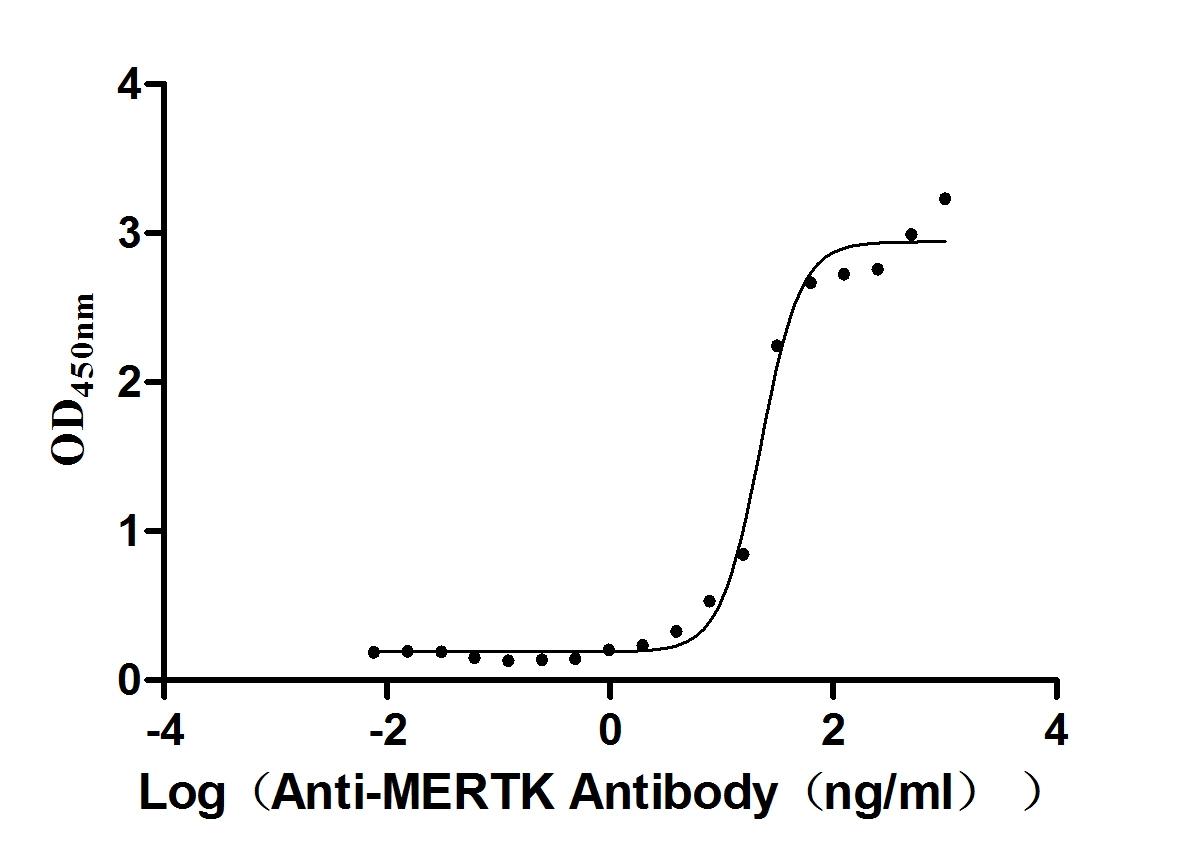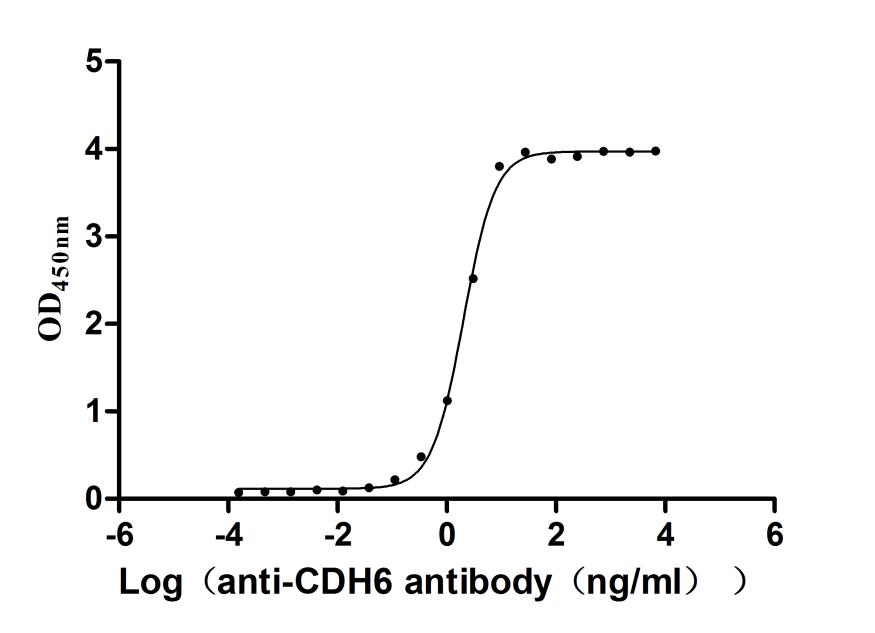Recombinant Human Ubiquitin-like protein ISG15 (Isg15)
In Stock-
货号:CSB-EP011843HU
-
规格:¥1344
-
图片:
-
其他:
产品详情
-
纯度:Greater than 90% as determined by SDS-PAGE.
-
基因名:ISG15
-
Uniprot No.:
-
别名:G1P2; hUCRP; IFI 15; IFI15; Interferon alpha inducible protein; Interferon induced protein 15; Interferon induced protein IFI-15K; Interferon stimulated protein 15 kDa; Interferon; alpha-inducible protein (clone IFI-15K); Interferon-induced 15 kDa protein; Interferon-induced 17 kDa protein; Interferon-induced 17-kDa/15-kDa protein; IP17; ISG 15; ISG15; ISG15 ubiquitin like modifier; ISG15_HUMAN; Ubiquitin cross-reactive protein; Ubiquitin-like protein ISG15; UCRP
-
种属:Homo sapiens (Human)
-
蛋白长度:Full Length of Mature Protein
-
来源:E.coli
-
分子量:44.3kDa
-
表达区域:2-157aa
-
氨基酸序列AWDLKVKMLGGNDFLVSVTNSMTVSELKKQIAQKIGVPAFQQRLAHQTAVLQDGLTLSSLGLGPSSTVMLVVQNCSEPLSILVRNERGHSNIYEVFLTQTVDTLKKKVSQREQVHEDQFWLSFEGRPMEDKELLGEYGLKPQCTVIKHLRLRGGGG
Note: The complete sequence including tag sequence, target protein sequence and linker sequence could be provided upon request. -
蛋白标签:N-terminal GST-tagged
-
产品提供形式:Liquid or Lyophilized powder
Note: We will preferentially ship the format that we have in stock, however, if you have any special requirement for the format, please remark your requirement when placing the order, we will prepare according to your demand. -
缓冲液:Tris-based buffer,50% glycerol
-
储存条件:Store at -20°C/-80°C upon receipt, aliquoting is necessary for mutiple use. Avoid repeated freeze-thaw cycles.
-
保质期:The shelf life is related to many factors, storage state, buffer ingredients, storage temperature and the stability of the protein itself.
Generally, the shelf life of liquid form is 6 months at -20°C/-80°C. The shelf life of lyophilized form is 12 months at -20°C/-80°C. -
货期:3-7 business days
-
注意事项:Repeated freezing and thawing is not recommended. Store working aliquots at 4°C for up to one week.
-
Datasheet & COA:Please contact us to get it.
相关产品
靶点详情
-
功能:Ubiquitin-like protein which plays a key role in the innate immune response to viral infection either via its conjugation to a target protein (ISGylation) or via its action as a free or unconjugated protein. ISGylation involves a cascade of enzymatic reactions involving E1, E2, and E3 enzymes which catalyze the conjugation of ISG15 to a lysine residue in the target protein. Its target proteins include IFIT1, MX1/MxA, PPM1B, UBE2L6, UBA7, CHMP5, CHMP2A, CHMP4B and CHMP6. Isgylation of the viral sensor IFIH1/MDA5 promotes IFIH1/MDA5 oligomerization and triggers activation of innate immunity against a range of viruses, including coronaviruses, flaviviruses and picornaviruses. Can also isgylate: EIF2AK2/PKR which results in its activation, DDX58/RIG-I which inhibits its function in antiviral signaling response, EIF4E2 which enhances its cap structure-binding activity and translation-inhibition activity, UBE2N and UBE2E1 which negatively regulates their activity, IRF3 which inhibits its ubiquitination and degradation and FLNB which prevents its ability to interact with the upstream activators of the JNK cascade thereby inhibiting IFNA-induced JNK signaling. Exhibits antiviral activity towards both DNA and RNA viruses, including influenza A, HIV-1 and Ebola virus. Restricts HIV-1 and ebola virus via disruption of viral budding. Inhibits the ubiquitination of HIV-1 Gag and host TSG101 and disrupts their interaction, thereby preventing assembly and release of virions from infected cells. Inhibits Ebola virus budding mediated by the VP40 protein by disrupting ubiquitin ligase activity of NEDD4 and its ability to ubiquitinate VP40. ISGylates influenza A virus NS1 protein which causes a loss of function of the protein and the inhibition of virus replication. The secreted form of ISG15 can: induce natural killer cell proliferation, act as a chemotactic factor for neutrophils and act as a IFN-gamma-inducing cytokine playing an essential role in antimycobacterial immunity. The secreted form acts through the integrin ITGAL/ITGB2 receptor to initiate activation of SRC family tyrosine kinases including LYN, HCK and FGR which leads to secretion of IFNG and IL10; the interaction is mediated by ITGAL.
-
基因功能参考文献:
- These results demonstrate that virus-induced IFN-lambda4 potently blocks IFN-alpha signalling by inducing high protein levels of ISG15 and USP18. Moreover, the data clearly demonstrate that DAA therapy restores IFN-alpha responsiveness in HCV-infected cells. PMID: 28630501
- IFN-gamma increases free ISG15 levels in the cytoplasm and ISGylation in the nucleus and cytoplasm, but in a manner distinct between MCF-7 and MDA-MB-231cells. PMID: 29626479
- Hepatitis E virus may promote production of IFN-alpha/beta and expression of ISG15 via ORF3 in the early stages, and increased ISG15 subsequently inhibited the production of IFN-alpha/beta. PMID: 29853735
- ISGylation is a ubiquitin-like modification that controls exosome release. ISGylation induction decreases microvesicular body numbers and impairs exosome secretion. Specifically, ISGylation of the MVB protein TSG101 induces its aggregation and degradation, being sufficient to impair exosome secretion. PMID: 27882925
- The species-specific gain-of-function in antiviral immunity observed in ISG15 deficiency is explained by the requirement of ISG15 to sustain USP18 levels in humans. PMID: 27193971
- HIV-1 IIIB infection of myeloid ThP-1 cells also reduced the IFN-alpha-mediated induction of the anti-viral gene, ISG15, but not MxA, revealing a functional consequence of this HIV-1-mediated immune evasion strategy. PMID: 29580840
- DNA damage induces ISG15 conjugation to p53 and this modification markedly enhances the binding of p53 to the promoters of its target genes as well as of its own gene by promoting phosphorylation and acetylation. PMID: 27545325
- Studied foot-and-mouth disease virus (FMDV) Lbpro targeting of ISG15. Show a previously undescribed mechanism by which viruses interfere with the ubiquitin and ubiquitin-like systems. PMID: 29463763
- ISG15 is able to trigger IFN-gamma production and other signaling pathways suggesting it is a potential cytokine that could interact with still unknown receptors. (Review) PMID: 28467275
- ISG15 induces cancer cell apoptosis by disrupting the NF-kappaB signaling pathway. This study highlighted a novel role of ISG15 in tumor suppression. PMID: 27659523
- The Interferon-stimulated 15-KDa protein (ISG15) rs1921 variant and ISG15 expression are associated with HBV-related liver diseases. PMID: 27626177
- findings revealed that MERS-CoV PLpro chiefly engages human ISG15 through its C-terminal domain; structure of MERS-CoV PLpro was solved to 2.4 A in complex with the C-terminal domain of hISG15; structure of MERS-CoV PLpro in complex with this domain exposed the interface between these two entities PMID: 28931677
- Our study demonstrates a protumor role of ISG15, and suggests that ISG15 is a prognostic predictor and a potential therapeutic target for nasopharyngeal carcinoma PMID: 26919245
- Results show that HERC5 mediates covalent ISG15 conjugation to parkin in mammalian cells and that ISG15 is conjugated to the Lys349 and Lys369 residues of parkin which increases its ubiquitin E3 ligase activity. PMID: 27534820
- Extracellular ISG15 signals cytokine secretion through the LFA-1 integrin receptor (CD11a/CD18) in natural killer cells. PMID: 29100055
- Results suggest that unconjugated ISG15 affects the functions of HCV NS5A through protein-protein interaction. PMID: 28543875
- This report demonstrates that ISG15 induced by Hepatitis E virus replication in Huh7-S10-3 human liver cells plays an immunomodulatory role by negatively regulating type I Interferon signaling and, thus, Hepatitis E virus sensitivity to type I Interferon. PMID: 28724761
- epletion of either ISG15 or UBE2L6/UBCH8 resulted in enhanced endogenous autophagic flux. PMID: 28186990
- unlike ISG15, ubiquitin and FAT10 are conjugated to a similar degree to newly translated and pre-existing proteins. PMID: 27926780
- This paper shows that ISG15 directly regulates Human Cytomegalovirus replication and that its accumulation restricts productive virus growth. PMID: 28202760
- The results suggest that integrin-adhesion-induced MRTF-A-SRF activation and ISG15 expression constitute a newly discovered signaling circuit that promotes cell migration and invasion. PMID: 26872785
- These data indicate that hepatic expression of PSMA6, which is upregulated during viral hepatitis, likely depends on TLR3 activation and, that PSMA6 affects the expression of immunoregulatory ISG15, a proviral factor in the pathogenesis of hepatitis C virus infection. PMID: 26833585
- ISG15 dysregulation may be involved in the pathogenesis of glomerular inflammation PMID: 26844778
- This study shows that interferon-stimulated gene 15 (ISG15) lowers Human respiratory syncytial virus growth through protein ISGylation. PMID: 26763998
- Data show the induction of signal transducer and activator of transcription (STAT)1 and IFN-stimulated gene 15 protein (ISG15) in Rickettsia conorii-infected human umbilical vein endothelial cells (HUVECs). PMID: 26560068
- ISG15 might serve as a novel prognostic biomarker in drinkers with esophageal squamous cell cancer PMID: 26617815
- Cellular ubiquitin is a substrate of ISG15 and Lys 29 on ubiquitin is the major ISG15 acceptor site. PMID: 26226047
- Microparticles released from Mycobacterium tuberculosis-infected human macrophages contain increased levels of the type I interferon inducible protein ISG15. PMID: 26036210
- The inhibitory effect of ISG15 on HCV RNA replication does not require its conjugation to substrates by HERC5. PMID: 26361997
- These data reveal a previously uncharacterized ISG15-dependent restriction of Listeria infection, reinforcing the view that ISG15 is a key component of the innate immune response. PMID: 26259872
- free ISG15 may have antitumor and immunoregulatory function in vivo in breast cancer PMID: 25749047
- Propose that Isg15-dependent degradation of p53 represents an alternative mechanism of controlling p53 protein levels, and, thus, it is an attractive pathway for drug discovery. PMID: 24844324
- Reovirus T3D infection induced STAT-1, ISG-15, IFIT-1, Mx1, and IFIT-3 expression. PMID: 25905045
- Results suggest that high ISG15 expression is an intrinsic feature of hepatocellular carcinoma and a trigger for tumorigenesis and metastasis. PMID: 25238261
- our work demonstrates that ISG15 is a previously unrecognized support factor for CSC in the PDAC microenvironment with a key role in pathogenesis and progression. PMID: 25368022
- intracellular ISG15 is IFN-alpha/beta-inducible not to serve as a substrate for ISGylation-dependent antiviral immunity, but to ensure USP18-dependent regulation of IFN-alpha/beta and prevention of IFN-alpha/beta-dependent autoinflammation PMID: 25307056
- The ISG15 conjugation system represents a critical innate response mechanism in cardiomyocytes to fight the battle against invading pathogens, limiting inflammatory cardiomyopathy, heart failure, and death. PMID: 25165091
- suppression of ISG15 by siRNA sensitized A549-CUG2 cells to vesicular stomatitis virus infection. PMID: 24452380
- ISG15 does not appear to play a key role in IFN-beta-mediated C2C12 myoblast cell fusion PMID: 23750257
- ISG15 is a potential prognostic marker in high-grade serous carcinoma of the ovary PMID: 24300530
- Results showed that ISG15 modification (ISGylation) of PCNA plays a key role in translesion DNA synthesis termination. PMID: 24768535
- These data support the interferon-induced generation of a Tsg101- and ISG15-dependent checkpoint in the secretory pathway that compromises influenza virus release. PMID: 24237697
- Findings support the development of ISG15 conjugation inhibitors for treating breast and also other cancers expressing oncogenic Ki-Ras. PMID: 23318454
- expression of the ISG15 and/or ISGylation system attenuates HIF-1alpha-mediated gene expression and tumorigenic growth. PMID: 24056783
- ISG15 is counteracted by vaccinia virus E3 protein and controls the proinflammatory response against viral infection. PMID: 24257616
- Our results suggest that ISG15 overexpression could be developed into a powerful gene-therapeutic tool for treating IFN-alpha-resistant HCC. PMID: 24024201
- HIV-1 infection up-regulating expression of ISG15 in cell lines. PMID: 24386835
- High interferon-stimulated gene ISG-15 expression affects HCV treatment outcome in patients co-infected with HIV and HCV. PMID: 23588721
- Activation of double-stranded RNA-activated protein kinase (PKR) by interferon-stimulated gene 15 (ISG15) modification down-regulates protein translation PMID: 23229543
- ISG15 deregulates autophagy in genotoxin-treated ataxia telangiectasia cells PMID: 23212917
显示更多
收起更多
-
相关疾病:Immunodeficiency 38, with basal ganglia calcification (IMD38)
-
亚细胞定位:Cytoplasm. Secreted. Note=Exists in three distinct states: free within the cell, released into the extracellular space, or conjugated to target proteins.
-
组织特异性:Detected in lymphoid cells, striated and smooth muscle, several epithelia and neurons. Expressed in neutrophils, monocytes and lymphocytes. Enhanced expression seen in pancreatic adenocarcinoma, endometrial cancer, and bladder cancer, as compared to non-c
-
数据库链接:
HGNC: 4053
OMIM: 147571
KEGG: hsa:9636
STRING: 9606.ENSP00000368699
UniGene: Hs.458485
Most popular with customers
-
Recombinant Human Nectin-4 (NECTIN4), partial (Active)
Express system: Mammalian cell
Species: Homo sapiens (Human)
-
Recombinant Human Signal transducer CD24 (CD24)-Nanoparticle (Active)
Express system: Mammalian cell
Species: Homo sapiens (Human)
-
Recombinant Mouse Tyrosine-protein kinase Mer (Mertk), partial (Active)
Express system: Mammalian cell
Species: Mus musculus (Mouse)
-
Recombinant Human Claudin-9 (CLDN9)-VLPs (Active)
Express system: Mammalian cell
Species: Homo sapiens (Human)
-
Recombinant Rat Gastric inhibitory polypeptide receptor (Gipr), partial (Active)
Express system: Mammalian cell
Species: Rattus norvegicus (Rat)
-
Recombinant Mouse Cadherin-6(Cdh6),partial (Active)
Express system: Mammalian cell
Species: Mus musculus (Mouse)



















